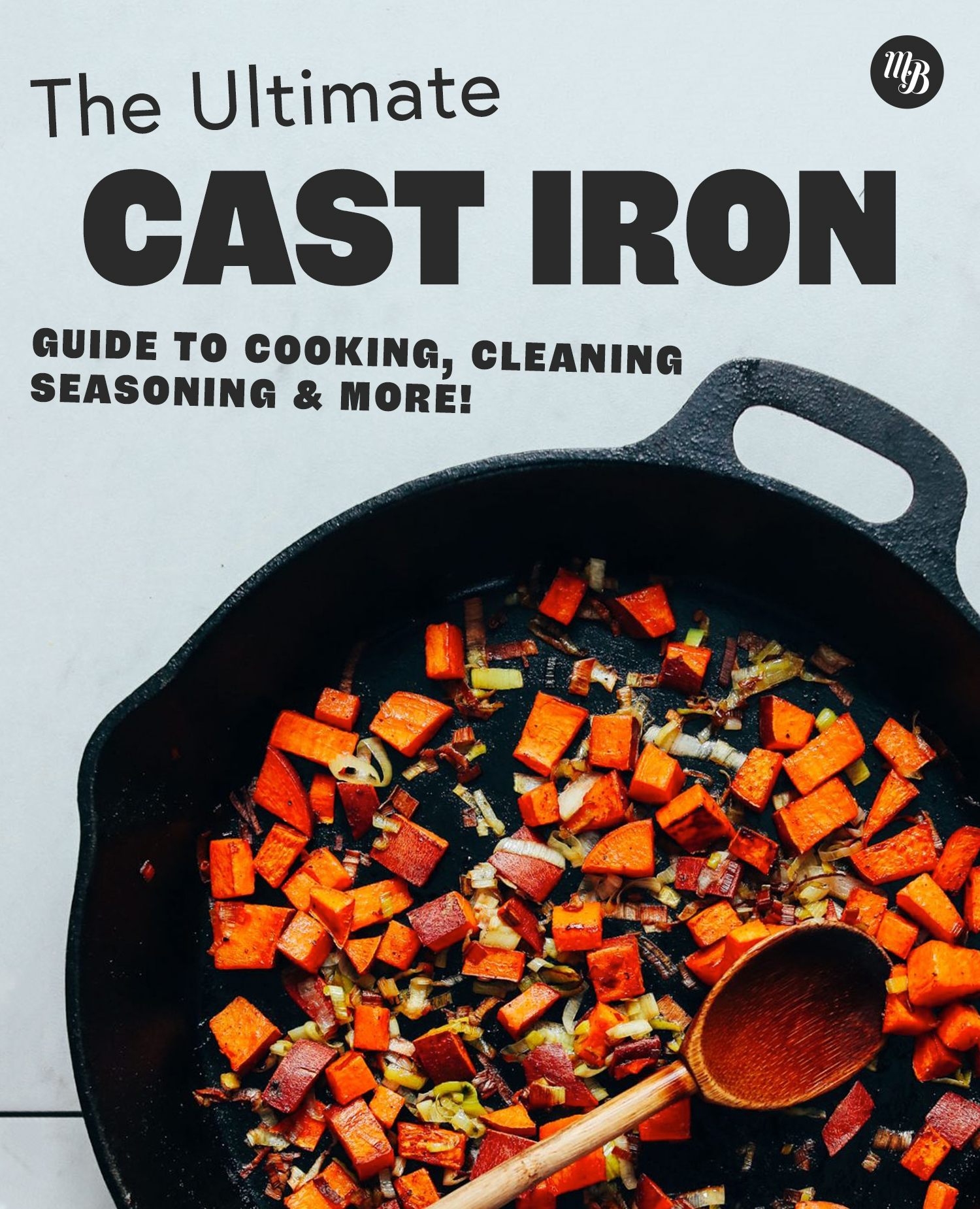
We’ve been wanting to create a guide to cast iron cookware for a while now as it’s our favorite kind of cookware, but can be a bit mysterious to work with if you’re new to the game.
So, today we’re answering your top questions and giving our favorite tips for cast iron cooking, cleaning, seasoning, and beyond. By the end of this guide, you’ll not only be a cast iron convert, but also feel confident in choosing, caring for, and cooking with cast iron cookware.
What is Cast Iron?
Cast iron is iron that has been melted, poured into a mold, and cooled. (source)
It’s incredibly resilient and durable, making it a desirable material for things such as pipes, machines, automotive parts, and (you guessed it) cookware.
When well cared for, it can last for generations, which is one of the many reasons to love cast iron pans. They’re durable, sustainable, and virtually indestructible. Not to mention, when properly used and cared for, they cook food beautifully.
Curious about how cast iron came to be? The earliest cast iron artifacts date back to the 5th century BC in China (source). Learn more about the history and resurgence of cast iron here.
How is Cast Iron Made?
Cast iron is most commonly made from a mixture of iron, steel railroad ties, recycled steel, castings shaken out from earlier production, and pig iron (a.k.a. crude iron, an intermediate product of the iron industry made by smelting iron ore in a blast furnace). This mixture of new and old metals makes it both sustainable and durable.
Curious about what the process looks like? We found this video demonstrating how cast iron is made very informative.
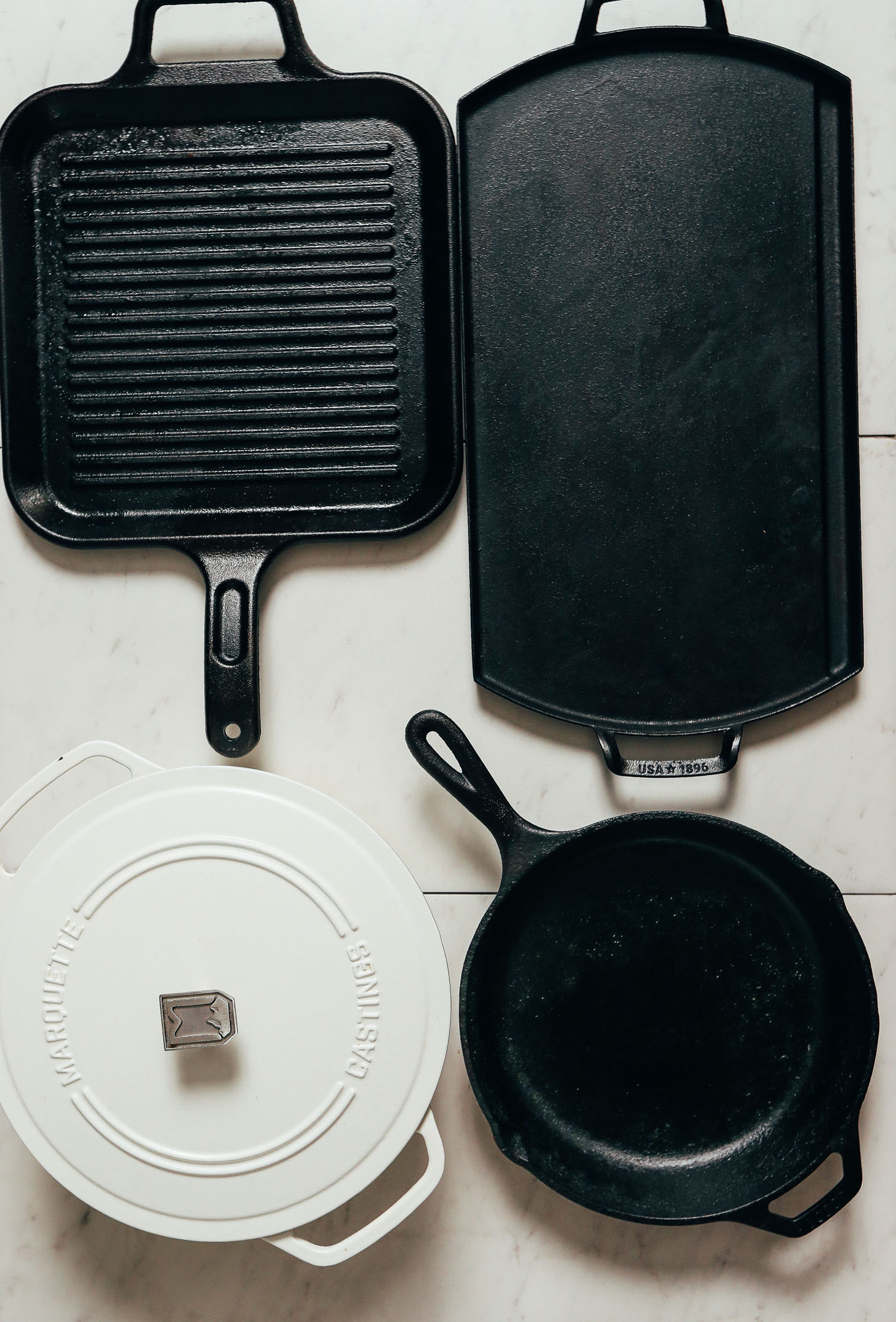
Types of Cast Iron Cookware
Best Brands for Cast Iron
Our preferred brand for cast iron cookware is Lodge* as it’s accessible, affordable, and has held up incredibly well after many years of daily use. All Lodge cast iron cookware also comes pre-seasoned (which we’ll get to soon), so you don’t have to do anything besides rinse your pan with a little hot soapy water and it’s ready to use.
Beyond Lodge, there are many more reputable cast iron cookware brands on the market, including Staub, Smithey, Le Creuset, Finex, Field, Stargazer, and Milo.
*We are not sponsored by Lodge. We just love and use their cast iron cookware almost exclusively.
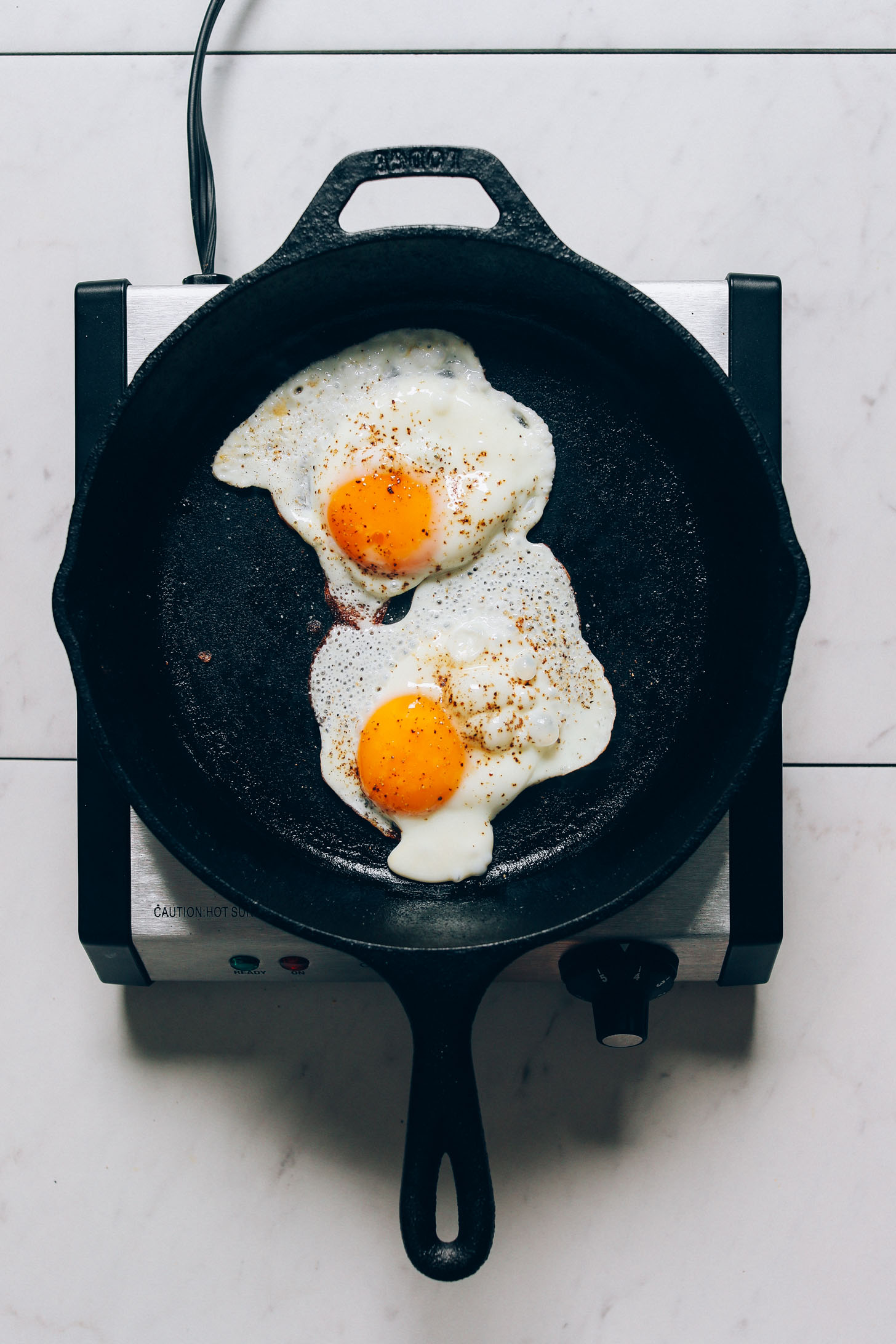
How to Season Cast Iron
Seasoning a cast iron refers to a process of baking oil into the surface to create a layer of carbonized oil, which forms a protective layer on top of your cookware. This not only helps give your cookware a sheen, but it also creates a virtually non-stick surface that makes for quick and easy cooking and cleaning. (source)
The easiest way to season a cast iron is to buy it already pre-seasoned. We love Lodge for this reason.
However, if you buy an unseasoned cast iron, simply:
- Heat your oven to 400 degrees F (204 C) and place a baking pan or foil on the bottom of your oven to catch any oil.
- Wash your cast iron with hot soapy water and dry thoroughly.
- Use a paper or cloth towel to rub a thin layer of a high-heat vegetable oil (such as canola or avocado) all over the surface (interior and exterior). You don’t need much — just a thin layer.
- Place pan upside down on a center rack and bake for 1 hour.
- Then turn off the oven but leave your cast iron inside the oven to cool for 1 hour.
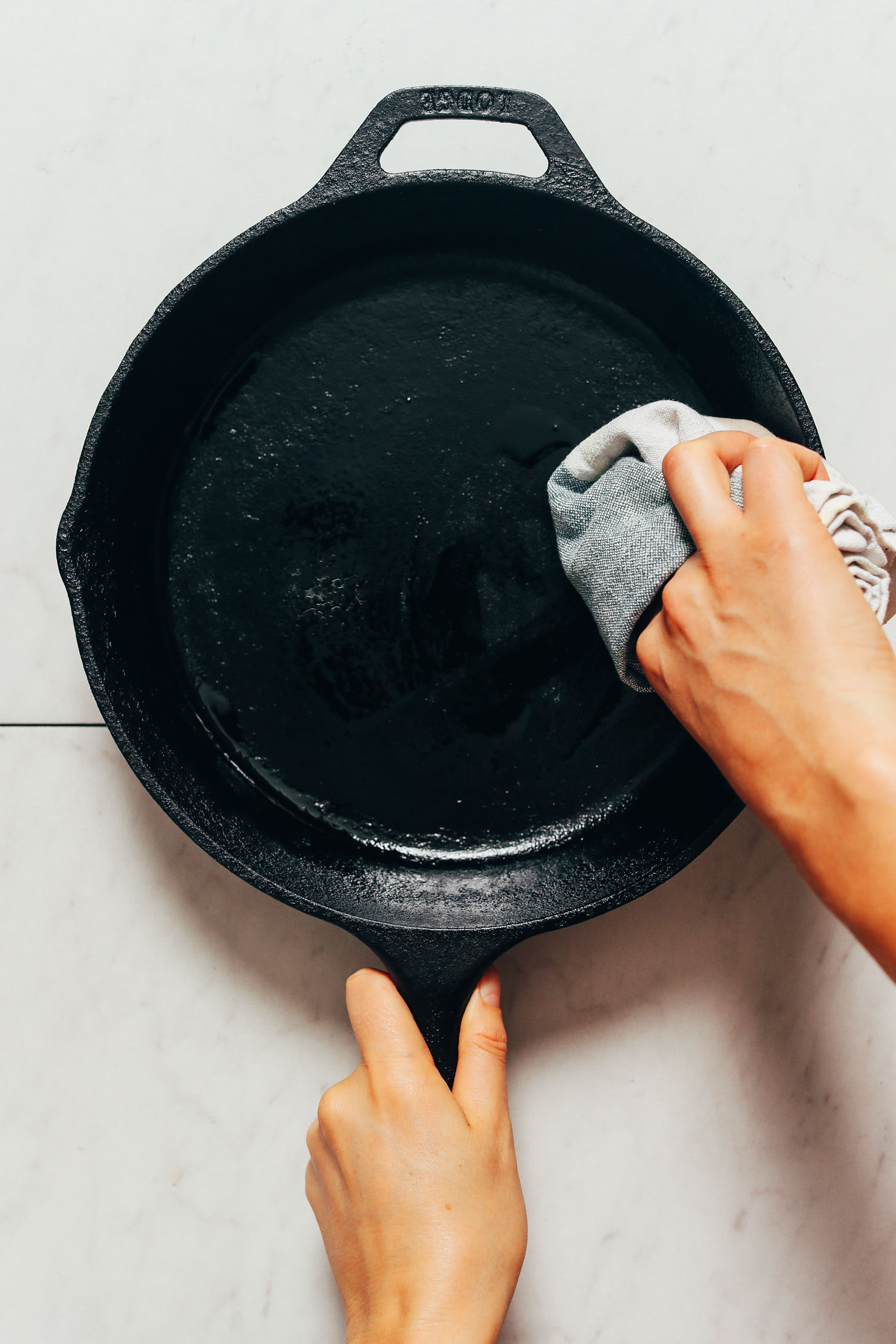
Your cast iron is now seasoned and ready to use. However, if you notice there isn’t a nice sheen visible, or if the non-stick surface isn’t working very well, repeat this process several times (this is common with new cast irons). This process can also be repeated over the life of the cookware to preserve its surface and integrity.
Still a little lost on seasoning your cast iron? We found these additional pointers from Lodge helpful.
How to Clean Cast Iron
Perhaps the most common question when it comes to cast irons, and the answer is simple: With water and a brush.
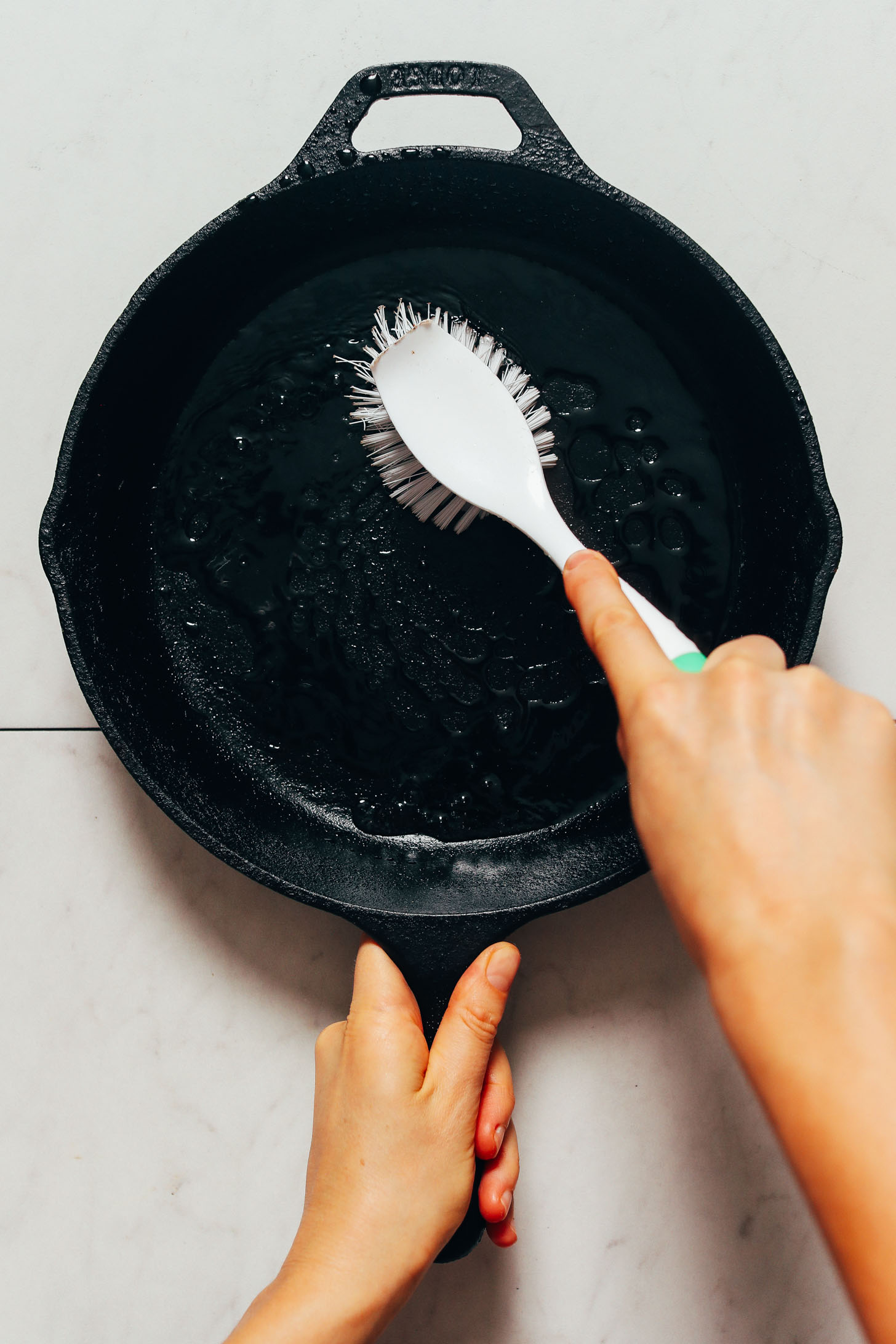
The only thing you really need to do to your pan after cooking is rinse with warm water and scrub clean with a medium-to-firm bristle brush. Once it appears clean, simply let it air dry.
FAST DRYING TIP: My other preferred drying method is to set your clean cast iron back on your stovetop over medium-high heat and heat until the water evaporates (which helps prevent rusting). This should only take 1-3 minutes (do not leave your cookware unattended).
If you notice there are bits of food or black specks in the pan, use a more firm bristled brush or a stainless steel brushing pad to gently scrub the problem areas. Note: steel wool pads (like Brillo or S.O.S. pads) are not the same thing and should never be used on cast iron.
Once the pan is clean and dry, rub it with a bit of oil (canola or avocado work best in my experience) and leave it to rest until its next use. This gives the cookware a little love and moisture and helps keep the seasoning intact.
There’s no need to bake or season again unless it’s lost its sheen or the non-stick properties are wearing off (in which case, repeat the seasoning process outlined above).
NOTE: Never ever put your cast iron in the dishwasher. Exposure to a moist environment will lead to rusting.
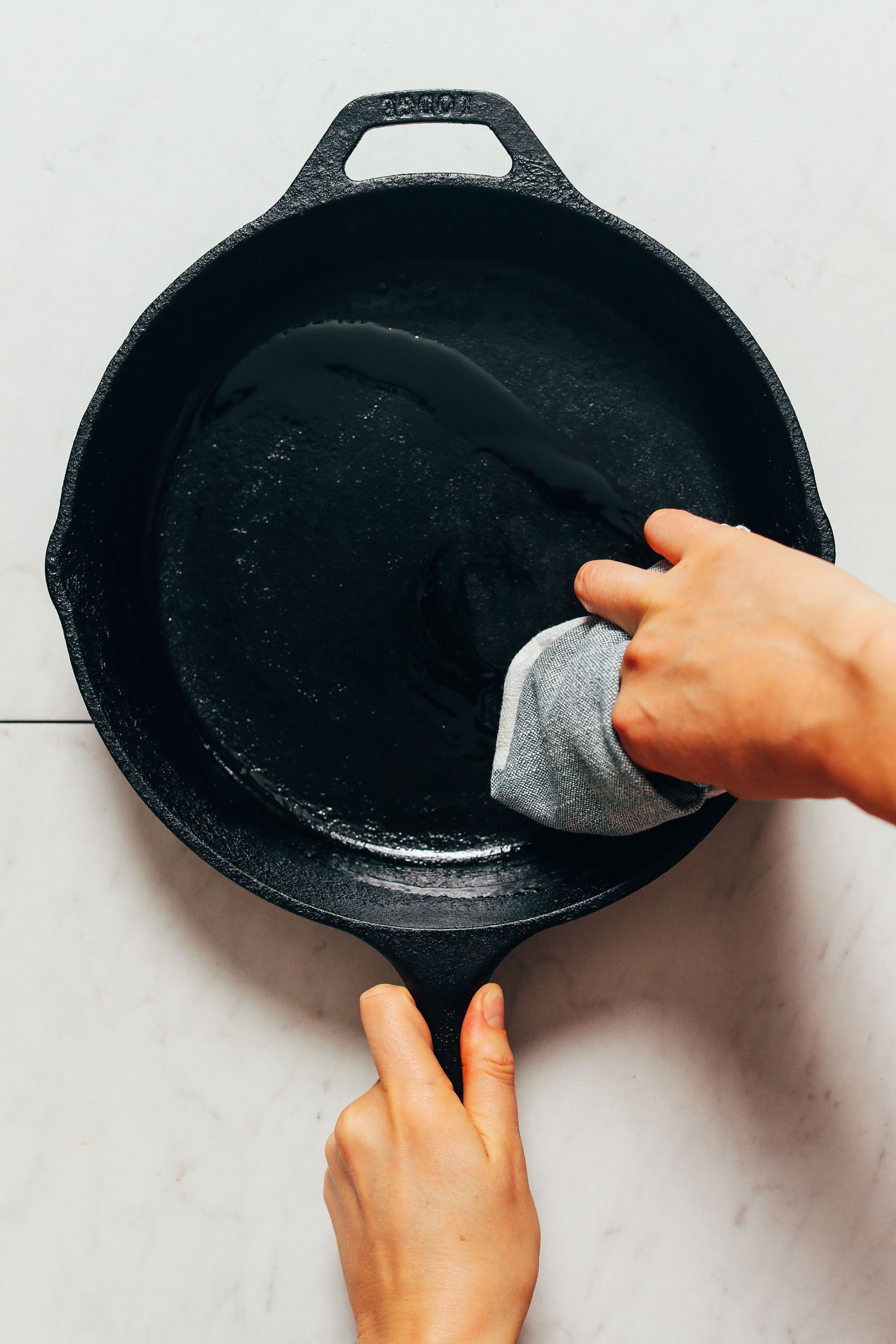
Can you use Soap on Cast Iron?
It’s not a good practice and there’s no need to use soap on a cast iron as it can deteriorate the surface and seasoning. On occasion, if you cooked something like raw meat and want to ensure there’s no residual bacteria, you can use a bit of mild soap and water to clean it. But for everyday cooking purposes, it’s not necessary.
How to Care for Cast Iron
The best way to care for your cast iron is to cook with it and occasionally rub it with some oil, especially if it appears dry. If it has lost its sheen or the non-stick properties are wearing off, you can repeat the seasoning process listed above.
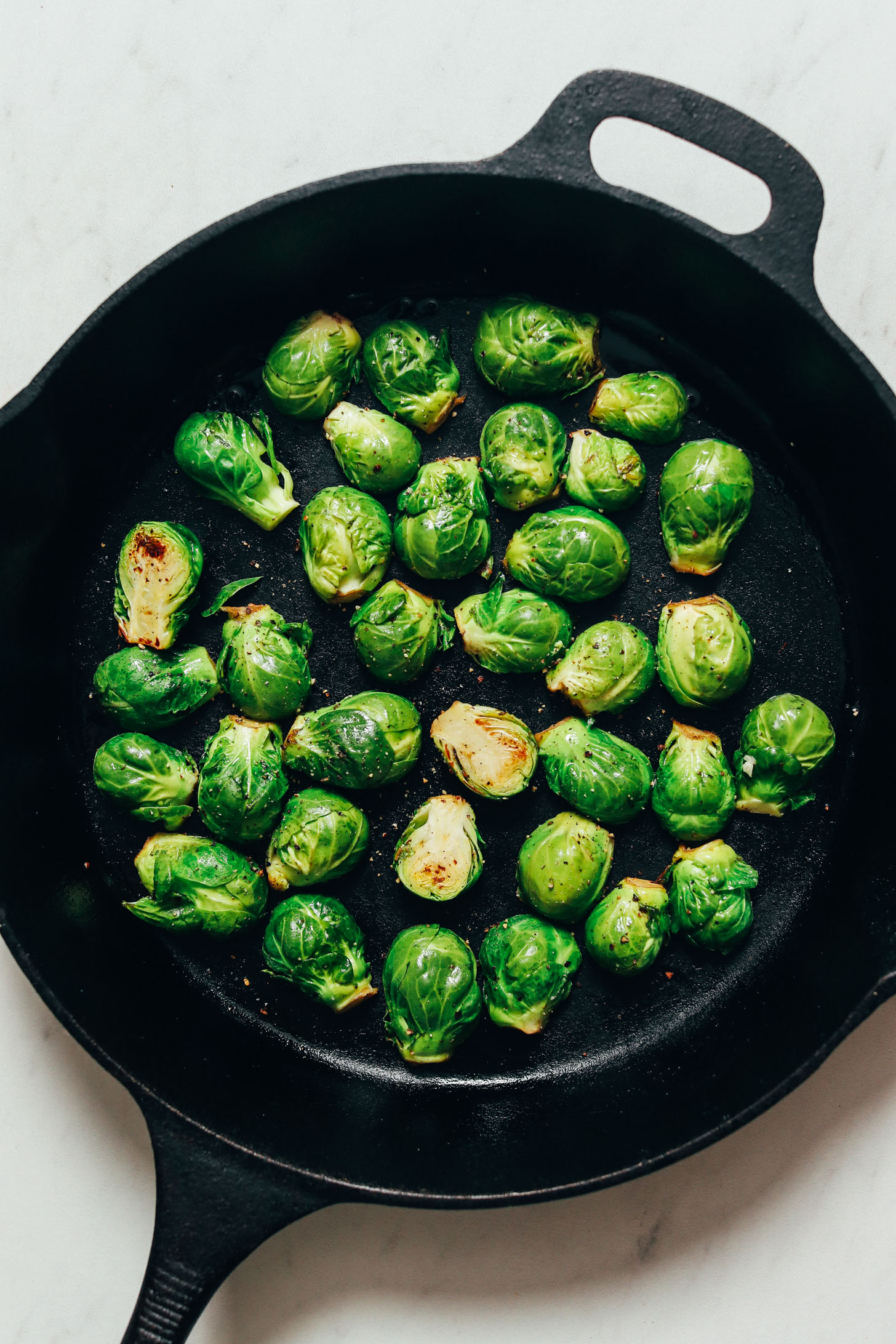
Worst Foods for Cast Iron
Speaking of caring for your cast iron, two things to limit or avoid are:
- Cooking acidic foods, such as vinegar or tomatoes.
- Cooking extremely alkaline foods, such as beans.
Overly acidic foods and beans can deteriorate the surface and seasoning over time (especially if your pan is new and the seasoning hasn’t fully set in yet).
However, these foods are okay in limited quantities. And because they aren’t always avoidable, just be in the habit of rubbing your cookware with a bit of oil after these uses to maintain the integrity of the pan’s seasoning.
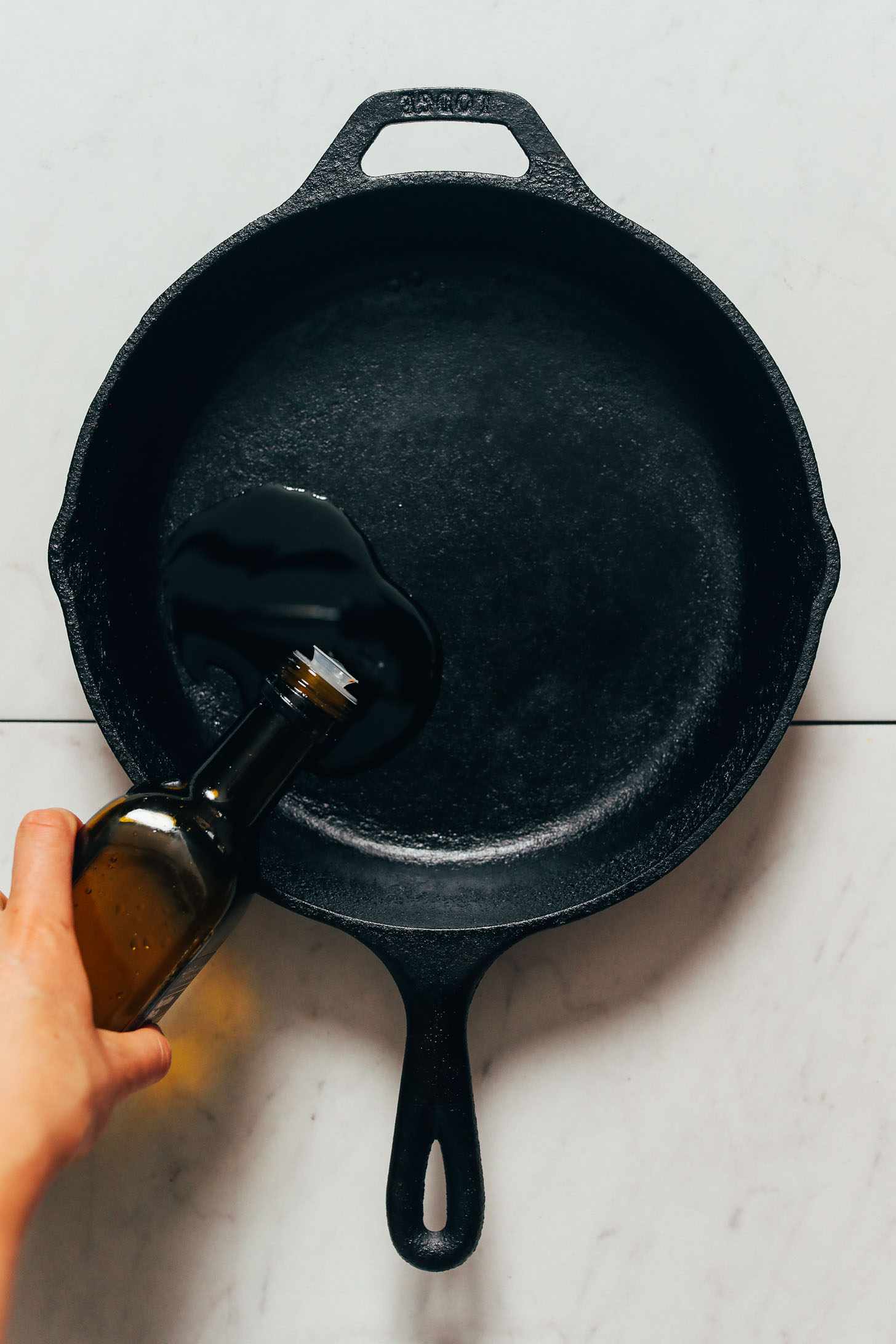
Do You Need to Oil Cast Iron or is it Non-Stick?
I prefer to use a little oil when cooking but it doesn’t require much (unless you’re going for a pan-fried effect, in which case you can add oil until it just coats the surface).
It’s good for the cast iron to be recoated with oil from time to time, but it doesn’t need to be oiled every time it’s used.
For instance, when frying an egg, I don’t find it necessary to add more oil to the surface before cooking. But when stir-frying veggies or grains, a little oil can be good to sear the ingredients and prevent them from sticking.
You may need to experiment a little with which foods benefit from oil when cooking and which foods can go without.
Best Uses for Cast Iron
- Searing – Cast iron is perhaps best at searing foods because it conducts heat well and disperses it evenly across its surface, making it perfect for getting a golden brown crust on whatever food you’re cooking. My favorite foods to sear in cast iron are chicken, peanut tofu, and veggie burgers.
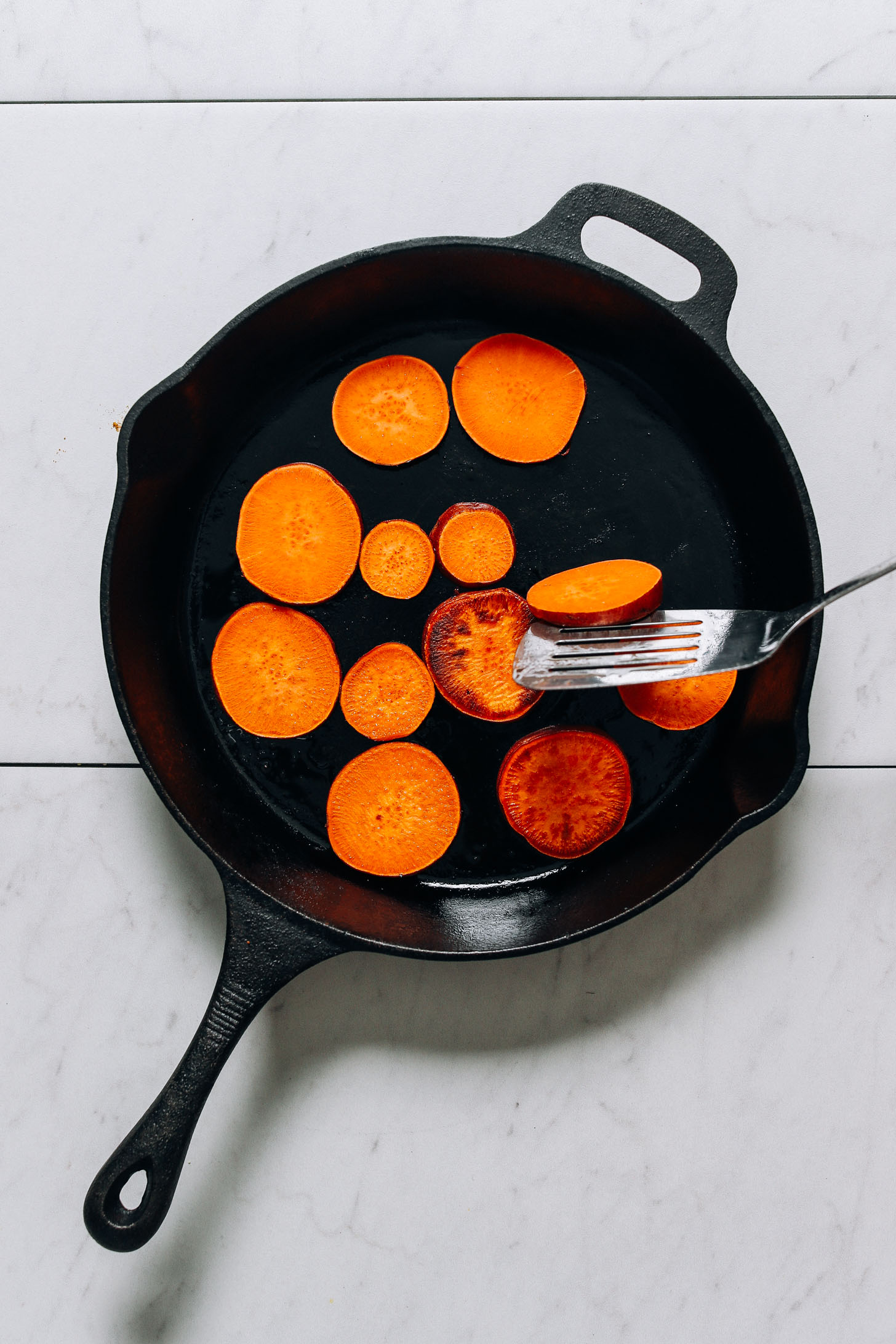
- Roasting/Baking – Perhaps my favorite cast iron use is roasting (and baking) because of how easy it is to sear foods on the stovetop and then throw them right into the oven to get golden and crispy (mmmm, yum). This is possible because cast iron cookware is oven-safe (take that non-stick!). You can roast and bake not only using a cast iron skillet (hello, skillet cornbread!), but also pots, Dutch ovens, baking sheets, pizza pans, and more. My favorite foods to roast using cast iron are our Beet Falafel, Miso-Glazed Brussels Sprouts, and Socca.
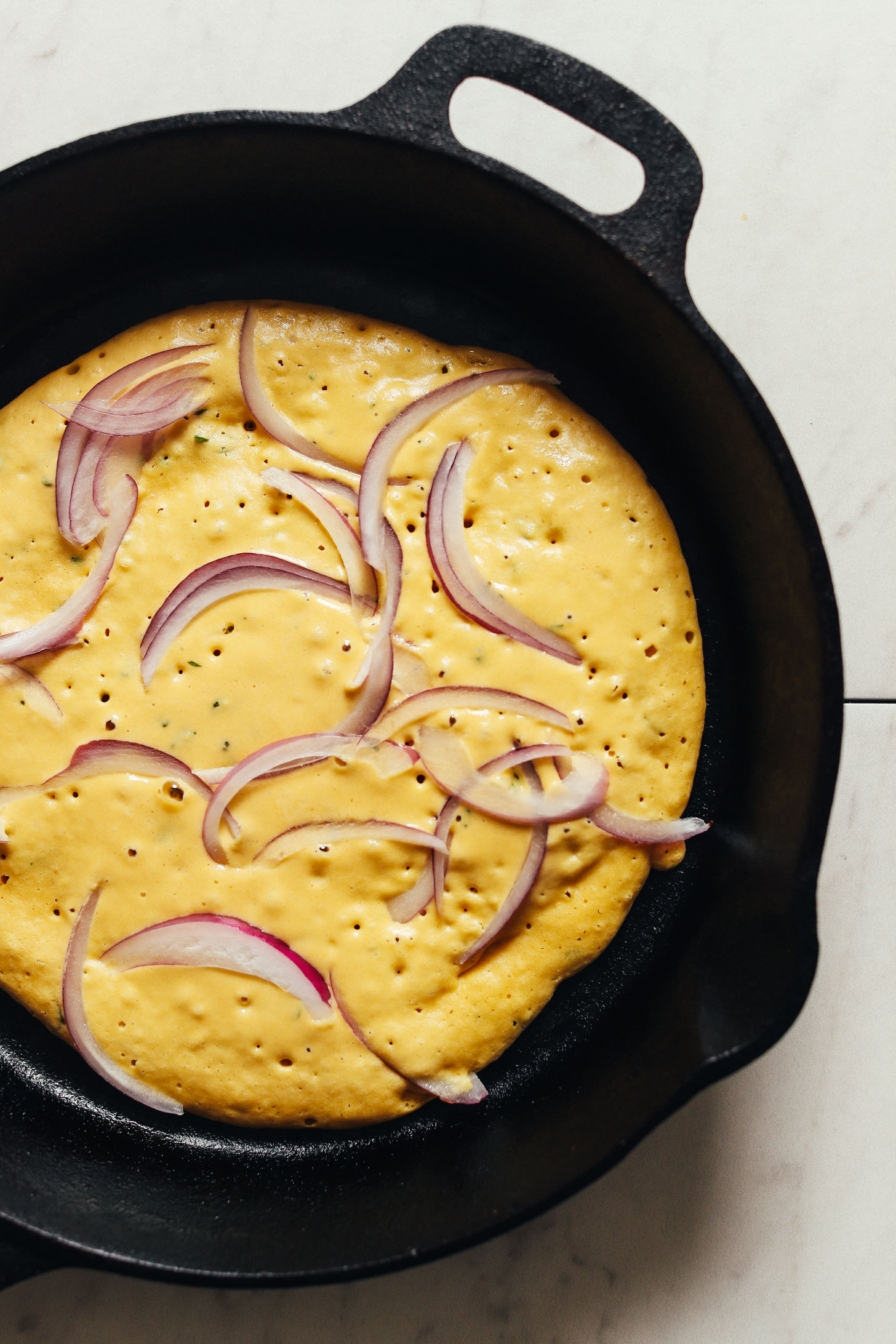
- Stir-Frying – Yet another fabulous use for cast iron due to its ability to get really hot and distribute that heat evenly is stir frying. This cooking method benefits from a bit of oil, in my experience, to help the food brown and prevent sticking. My favorite foods to stir fry in cast iron are Tofu Stir-Fry, Tempeh Stir-Fry, and Quinoa “Fried Rice.” But it’s also great for stir-frying just about any vegetable, grain, or meat (if not vegetarian or vegan).
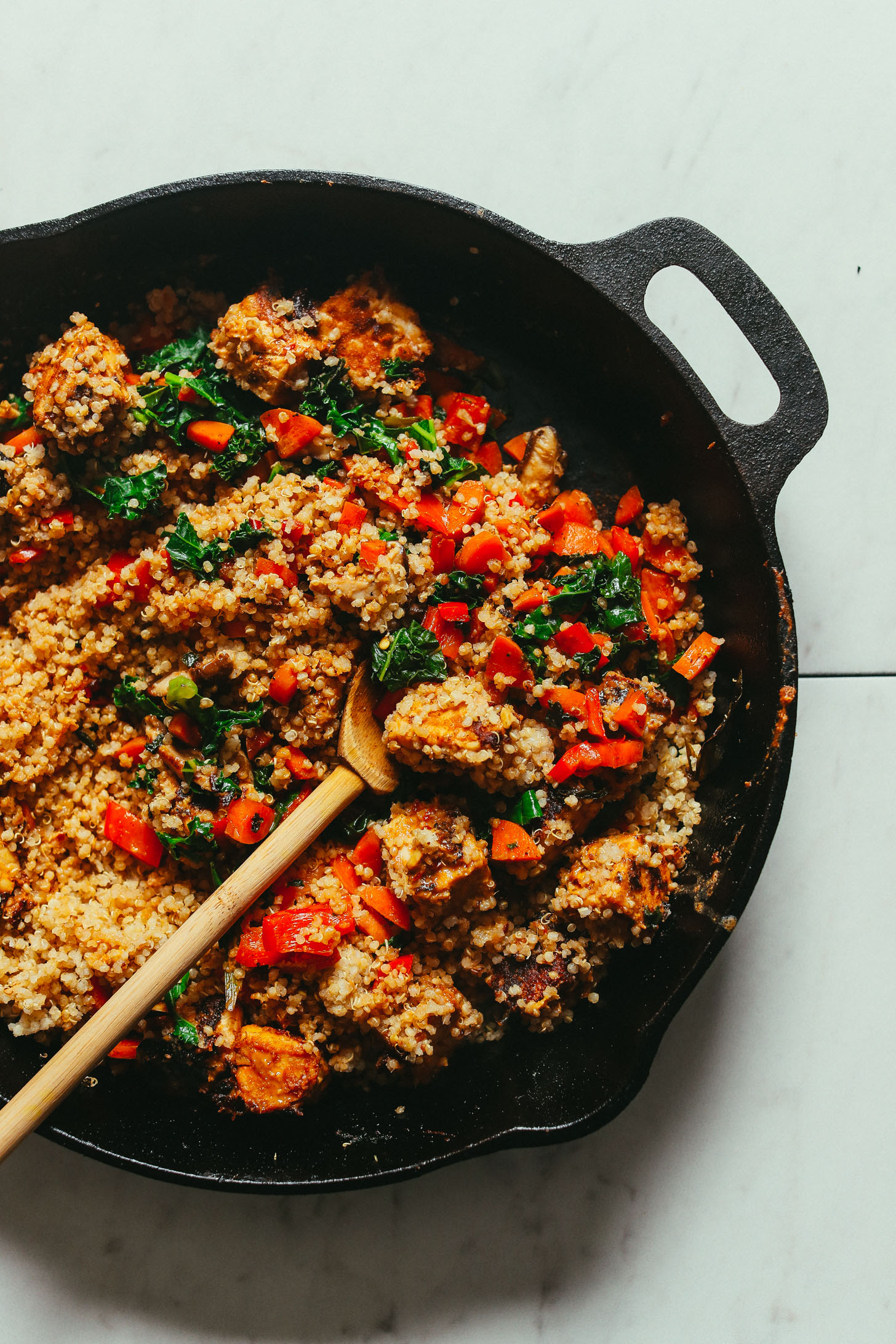
How to Fix a Rusty Cast Iron
If your cast iron is rusting, no worries. These things happen, especially when cast iron is exposed to moisture over a prolonged period of time or if the seasoning has worn off.
If your cast iron rusts, simply repeat the seasoning process, giving special attention to the scrubbing and cleaning process at the beginning, ensuring all rust gets removed by using a stainless steel brush pad as needed.
Health Benefits & Risks of Cast Iron
Last but not least, the health benefits and risks of cooking with cast iron. I found Andrew Weil to have a great explanation of both sides of this debate.
“Cast iron cookware does ‘leach’ iron into food and that can be an advantage, not a disadvantage, particularly for pre-menopausal women who don’t get the 18 mg of iron they need daily,” according to Weil.
He went on to cite a study published in the 1986 Journal of the American Dietetic Association that showed “cooking in cast iron skillets added significant amounts of iron to 20 foods tested,” including increasing the iron content of 3 oz of applesauce from 0.35 mg to 7.3 mg and scrambled eggs from 1.49 mg to 4.76 mg.
On the other hand, this can be a disadvantage for people who already get an overabundance of iron in their diets. Weil explains, “There’s plenty of iron in red meat, beans, lentils, millet, chickpeas, dark leafy greens, molasses, dried apricots, dried peaches, pumpkin and sunflower seeds, pistachios, walnuts, almonds, scallops, clams, oysters, soybeans, and many other foods.”
He also states that cast iron cookware should not be used for deep frying as iron can accelerate the oxidation of fat and cause it to become rancid.
That concludes our guide to cast irons! As you can tell, we’re avid cast iron enthusiasts and use them as our go-to every day.
We hope this guide was helpful. But if you have more questions about cast iron, let us know in the comments!

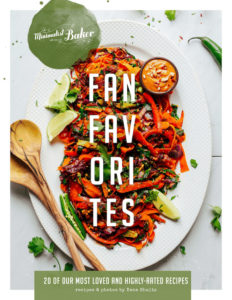
Sheila Patterson says
When I rub oil on my skillet with paper towel the paper turns black! This is after I clean it, sometimes with a bit of soap, but sometimes just scrubbing or wiping. Can you help? I gave away my 65 year old cast iron, and this one is fairly new. Should I re-season it? Thanks.
Hi Sheila, it’s normal for the paper towel to be a little black, but if it seems excessively so, re-seasoning could help!
Robert Dunn says
I have a set of 3 iron skillet which went thru a flood couple years ago. they are caked with the dried mucky film from the nasty water left behind. Knowing that cast iron is porous, are these skillets salvageable? and if so please direct me on how to restore them. Love cooking with these skillets
thank you
Hi Robert, we’re not sure! It could be worth a try to scrub them well and use a little bit of a mild soap. Then use the “How to Season Cast Iron” and “How to Fix a Rusty Cast Iron” sections in this article to restore the surface.
Michele says
Thankyou for your article, I recently bought a Pre-Seasoned Dutch Oven, that the lid can be used as a skillet, I haven’t used it yet mainly because I was a little scared of ruining it. I have a cast iron grill pan that I bought years ago, I didn’t understand the importance of proper usage and so I thought I ruined it. But in the article,I read I could fix the issue, so I’m going to try to bring it back to life
We’re so glad this guide was helpful!
Sarah Tee says
Thank you for this helpful article. I have a cast-iron saucepan (pot with a wooden handle) that was given to me and I am not really sure what to use it for. I wouldn’t really be searing anything in it. Any suggestions would be appreciated.
Is it ceramic coated? Assuming so, anything you’d use a saucepan for!
Silvi says
Hi – what size would you recommend for most of your recipes / a family of 2 adults? Thanks so much :)
12 inch! I also own a 10 inch which is lighter and convenient for single meals / reheating food, but a 12 inch will do more for you.
Eugene says
It’s best to use flax seed oil for seasoning cast iron rather than canola or other vegetable oils.
Betty Lou Blazic says
Thank you so much for all the information!!!
We’re so glad you find it helpful! xo
Judit says
What can you say about enamel cast iron? It avoids the leach of iron into the food, but I’ve noticed the “non stick” isn’t quite good as when the cat iron is seasoned with oils.
Yeah, it’s not as nonstick. I generally prefer enameled for my dutch oven! But stick to plain cast iron for my skillets.
Zoey says
This is an amazing article!!! Thank you for sharing! We have a Staub cast iron pan and I just tried to season it this afternoon, and I tried using Sesame oil because I read it has a high melting point (410) and we dont have avocad or canola in the house. Let’s just say it was a disaster – left a VERY sticky brown residue all over the surface (interior and exterior) of the pan. Spent an hour scrubbing it clean. Do you think it was the fact that I used sesame oil, or was there another issue!?
Oh no! Sorry to hear that, Zoey. It sounds like maybe you used toasted instead of untoasted sesame oil?
Dee says
Hello Dana! I would like to thank you (and everyone who contributed their experiences and expertise) for the information in this post. I found it to be very informative.
I also use cast iron and have noticed that as of the past few months, I use this cookware exclusively (and believe me, I have LOTS of other cookware). I have three cast iron skillets: a 10″ Lodge chef skillet, a 9″ Griswold, and an 8″ Wagner. I wouldn’t get rid of them for anything in the world! On the other hand, my other cookware will eventually have to go since I don’t use it that often.
Thanks for sharing, Dee! xo
Taylor Van Antwerp says
Hello,
Thanks for this comprehensive review and guide. This the guide available to download and print. I would love to have a copy in the recipes binder for quick reference.
Thanks!
Kc says
Hello i understand the pan should be pre seasoned after cleaning , the question is should i rinse the pan before use as the pan may get sticky the the oil coating. Thanks.
Holly says
Thanks for your post! I just bought a Lodge 12-inch skillet actually the day before you posted this guide, so I will definitely be referring to this. My question is: the first time I tried using it to make pancakes, they stuck really badly. And I did try heating up the pan first and coating it with oil. It seems like when food sticks to the pan that means it needs to be seasoned, but I thought that Lodge already came pre-seasoned. Is there anything else I should do to the pan before cooking with it again? Does the food getting stuck issue resolve itself the more I use it? I generally am OK with using oil for cooking but would like to not have to use a lot of oil. Thanks
Over time it becomes more and more nonstick. Another trick is to not touch your food until it’s cooked fully (it’s like trying to flip an egg or pancake before it’s done cooking and it sticks).
Jackie Sarlitt says
Thank you so much for the information. I have been looking at the cast iron braiser for a while and like the one that has an enamel finish…. how do you feel about that finish? Is it easier to use and clean up? I love LeCreuset ( like the colors!) but I see there is a Lodge Braiser with enamel coating that is about a third of the price. I was thinking that the pan could be used everyday since it has a shorter rim. Also, with the enamel finish, would it still be necessary to avoid beans and tomatoes ? I use both A LOT!
You could cook beans with the enamel coating. But the enamel coating doesn’t necessarily mean easier clean up in my experience. Let us know what you decide!
Anna says
We cook with cast iron almost exclusively, so this information is really helpful. I have a question: we have been looking for an affordable, quality brand cast iron pot—not a small dutch oven—a 2-quart pot (and other sizes) not unlike the stainless steel ones we have. We are shocked Lodge doesn’t carry one. Do you have any brand suggestions? Also, on another note, recently I saw Lodge has a bakeware line and am looking forward to getting their casserole dish as soon as I can.
Oh amazing! You know, the other brands I linked in the post all seemed reputable and well reviews so perhaps try one of those!
Michele says
Best place to find good quality cast iron is garage sales—irl or online. I scrubbed all the rust off my grandmother’s cast iron pans—close to 100 years old now—and re season ed. A lot of work, but so worth it for old Lodge pans. Now my mom thinks she is a French chef cooking perfect steak every time!
Licia P. says
I have a glass cooktop and still use my cast iron pan because I love it so much. Just have to be careful not to drop the pan (glass cooktop could break), or roughly move it around (think the old jiffy pop way of making popcorn) to prevent scratching.
Michele says
I always start with a spray of oil for this very reason—it protects the pan and your food. I can then just wipe out the pan with a damp towel after. If food sticks: It helps to clean the pan immediately—put it back on the stove with a little water, then you can usually gently scrape off the food—gently (no metal spatula)!! If it’s bad or burnt, the same reason you should avoid cooking acidic food in cast iron is the same property that works to clean it. I throw a tomato half in the hot pan, let that soften up the debris, then scrape off with a wooden spoon. Just reoil after.
Heather Beck says
We have a plethora of cast irons and use them daily on our glass cooktop electic stove. It’s totally fine, you’ll just have a learning curve with each burner with your particular cast iron to be sure you’re getting optimal heat for whatever you’re cooking. One of our burners is super hot and we could sear a steak on the #3 setting out of 10 heatwise on the dial. Hope this was helpful and have fun cooking!
William Moore says
Many years ago I purchased a Shipleigh antique cast iron waffle iron in an antique shop in Cripple Creek Colorado. This waffle iron dates back to 1890 – 1900 is approximately 10″ in diameter and has a wound spring handle, sits in a deep rim stand with a cup opposite the handle notch like a hip and socket This is where the ball joint that holds the side irons of the waffle iron together is placed. You put the iron on the stove, heat it, flip up the top part of the iron up, add the batter and flip over to cook the opposite side. This waffle iron makes the crispiest sourdough waffles imaginable. Old cast iron is usually very well made (not made in china) and can often be found in antique shops. Before purchasing, make sure there’re no cracks and if it’s rusty, make sure the rust hasn’t pitted the surface and you should be fine . All you need to do is season it
Bobbi Sue says
I do have a question! I just cleaned up and seasoned a very old cast iron skillet that was my great aunt’s. I was very excited to use it. The first thing I cooked were these vegan breakfast sausage patties (they look like real meat) that had a maple flavor to them.
I did use some oil in the pan first. They weren’t sticking, but by the time they were done cooking there was a thick layer of black stuff all over the pan.
It took forever to get it off and there are still a few very small spots I could not get (my arms felt like they were going to fall off from scrubbing!).
I even boiled some water in the pan for about 3 min first to try scraping it off, which helped but there was still a lot left to remove.
Everyone raves about how easy cast iron is so I have to wonder if this is operator error? Or were these sausages a bad idea since they had a sticky maple syrup flavor to them?
Any help is very much appreciated because I am scared to cook with it again if it takes 30min of hard scrubbing to clean it!
It sounds like there were already some remnants of food stuck on from a previous cooking session that only got even more solidified during this cooking. OR the sausages created a sticky film that got very cooked into the surface. This is normal. I generally rinse and use a brush to scrub. And if there are any stubborn spots I let it soak in warm water for 10 minutes then use a spatula to gently scrape away any remaining debris.
Bobbi Sue says
Thank you! I will maybe avoid these sausages again….but if I do find myself with a thick film on the pan again I will try soaking it for longer. I only did a few minutes.
When you sear something like tofu or cook brussel sprouts, do you find that you have a thick black crusty film? I am thinking it was just the sausage and I am trying to manage my expectations so I don’t panic next time. Thanks for all of your help!
Not generally, but occasionally it happens. I find a little oil in the pan at first goes a long way. And the more you use it, and the less you scrub it, the better the seasoning / coating naturally prevents that from happening!
Nicole says
What pans do you use for cooking acidic foods
Stainless steel or a non-stick pan.
Timothy Turner says
Do not soak your cast iron… all you do is put some water in the pan and let it simmer for a minute or two and it will come off with a wood Spatula Do not use Dish soap it will take off your seasoning. Put it on the stove heat it after it is dry with a dry rag coat the pan with a little crisco it does not need much
Lori says
Can the really rusty cast iron cookware I see in resale stores be saved? Or are they too far gone?
According to my research they can be saved. They’re somewhat indestructible. Try the instructions listed in this article (Lodge had some great ones for how to save rusty cast irons). Let us know if you try!
Derron Tume says
I inherited some cast iron pans that were left uncared for, I used some wire wool and vinegar to remove the rust and then seasoned them as mentioned and the were just as good as new.
Great! Thanks for sharing!
Michele says
BUY THEM!! You have found a treasure. Yes, it takes a lot of work, but so worth it to get good cast iron instead of the cheap, poorly made stuff. Great info online to take you through the steps . I refurbished 4– 1giant, 1 medium for meats, 1 medium for my gluten-free, vegan use, and 1 small perfect for baking. Thanks, Grandma
N icki says
I saved mine! Before my dad passed away he was an antique dealer- he had an old rusty cast iron pan in the garage that came along with a box of other treasures. I took it, scrubbed it, oiled it with olive oil and baked it like Dana’s instructions and now we use it all the time. After cooking usually just wipe it out with a paper towel and sometimes will put a thin layer of olive or avocado oil on it to keep it shiny. It is safe to use a mild soap occasionally, like Seventh Generation, but dry it with a towel so it doesn’t get rusty.
The initial scrubbing did take a little elbow grease, but it’s well worth it.
We’re so glad the instructions worked! Thanks for sharing your experience, Nicki!
Cami says
Hello and thank you for posting on this topic! We love our cast iron too but always have the issue of black residue coming off on food or at least when we wipe the interior of the pan. We clean with no soap, just warm or hot water and a bristle brush as needed. We pat dry or let dry over heat. Both my pans are Lodge. I’ve even tried reseasoning one of them with flax oil but I still have the same problems. What is the residue and how can I prevent it from coming off pan? We cook mostly with olive oil or coconut oil. Thanks for any ideas!
Sometimes the food you cook in cast irons or if you cook it over high heat for a prolonged period of time can contribute to blackened debris. In my experience this is normal and I simply rinse, scrub with a bristle brush, and use a spatula to gently scrape away any remaining debris. Hope that helps!
Laura Schroeder says
Be sure to heat up your cast iron pan before putting food in, never cook in a cold cast iron skillet. This will prevent sticking and debris.
Thanks for sharing, Laura!
Lynne Smith says
Thank you for this article
I inherited my moms cast iron skillet and I didn’t know how to take care of it and food was sticking to the bottom.
Now you answered all my questions and it should be good as new again.
xo!
Barb says
When you say not to cook beans in cast iron, do you mean green beans, or black beans, kidney beans,etc? And are you talking about soaking and then cooking, or just heating beans from the can?
I wouldn’t cook them in the pan from raw or soaked. But reheating from the can is fine.
Jeff says
I’ve been using cast iron almost exclusively for the past 10 years. Lodge does make good pans!
For those who have blackened bits in their food: it’s your seasoning. Make sure the pan is heated before seasoning it to evaporate any water from the pores of the metal. Perhaps there was moisture trapped between the metal and the seasoning? I only use shortening or lard or canola oil to season my pans and don’t have any issues. Flax oil does have a higher smoke point, but the polymerization it creates is more rigid and can break off while cooking causing it to end up in your food as black flecks. You can also do a quick seasoning on your stovetop on medium high heat. Preheat it and then towel on a light coat of oil let it smoke and dry out then towel on some more. Faster than the oven method for a quick maintenance. Pizza is amazing in cast iron!
Thanks for sharing!
Vanessa says
Would virgin coconut oil work? I don’t keep canola or avocado oil in the house.
Should work, just check the smoke point.
An says
Thank you for the brilliant informative post which will save me hours of research and confusion as I look to buy some new cookware! Thanks for sharing your knowledge and experience.
xo!
Grace says
Can you use cast iron pans on a glass cooktop?
It’s not ideal but I believe it is possible. Check our stove manual if you have one to see.
Cami says
We do without issue. Just don’t slide your pan around so you avoid any unnecessary damage to cooktop.
Meera says
This is a super helpful guide! Thanks you! What’s your preferred brand for an enameled Dutch oven?
This brand.
Meera says
Thank you!
JWilkins says
Your comment about soap is absolutely false. Detergent (i.e. Sunlight) and warm water will not do nothing to the seasoning. The seasoning is made up of polymerized oil, and soap and water will not harm it in any way. Cleaning this way will also drastically reduce the need to hit it with more abrasive techniques, such as steel wool, which will definitely mess up the seasoning.
Thanks for sharing your insights! We still prefer not to use soap but if it works for you that’s great!
Cathie says
I have a glasstop stove so I am unable to use cast iron pans. I noticed you used a single burner in the blog pictures. What single burner do you recommend to use with the Lodge cast frying pan?
The one we have is by Cuisinart but there’s so many great brands out there now!
Bobbi Sue says
Oh wow…did not know that! I definitely used it on my glass top stove. Yikes! I will need to get a burner or just use it for baking maybe.
Cami says
We use ours on a glass cooktop without a problem. Just don’t slide or bang it around. Set it on the burner and cook.
Richard Davis says
I burn the black crust on the outside and bottoms of my cast by placing it on red hot coals till it burns off the remove and let it cool on it’s own. Then reseason it as if it is new.
This is so helpful! Thanks, Richard!
Cami says
I’ve heard bonfires work too!
Lori Burnham says
Super interesting, appreciate this article!😉
Dave says
Flax seed oil is the best for seasoning
Nancy C Bachmann says
There are plenty of instructions for cleaning rusty pans but none that tell how to remove baked on lumps on outside of skillet
Richard (another commenter) just shared his method!
Nancy Bachmann says
I dont see any response from Richard or anyone else
Here’s what he said: “I burn the black crust on the outside and bottoms of my cast by placing it on red hot coals till it burns off the remove and let it cool on it’s own. Then reseason it as if it is new.”
elisabeth says
A relative insists that the cast iron pan has to be heated to 350 degrees before using on the stove. So, EVERY time he cooks, he first heats up the pan in the oven to 350. Is this necessary? Seems like a lot of energy just to fry an egg or something. And it heats up the kitchen in the summer.
Wow sounds like a lot of extra work. Not worth it in my opinion.
Courtney says
This was really helpful – thanks for sharing! I got a Lodge cast iron skillet, and it’s starting to show some wear, but you read tons of differing opinions online from how to re-season. I trust you guys :) I’d love more posts like this since you guys get a lot of use out of your cooking tools! :)
Thanks, Courtney!
Stephen D. says
If you find your suffering from iron deficiency, no problem.Just lick your cast iron skillet for a couple of minutes each day, and watch the years fall off.Be sure the skillet is cool to the touch first.
Kelli Page says
I use my large cast iron skillet to roast chicken in. The dark meat cooks perfectly simply because the bottom of the skillet acts as a 2nd source of heat, while the white breast meat is not overcooked. I slice onion, carrot and celery to the oiled skillet and set the chicken on top and roast at 350 degrees, so satisfying!
Thanks for sharing!
Rosanne Harbison says
What about cleaning and caring for coated cast iron pans?
Meaning enamel coated? You can use soap on coated. But still don’t put in the dishwasher.
Ronald Rolla says
I appreciated all the research you presented. Many good tips and information I was not aware of and will use with my cast iron skillet.
Kelsey says
Thank you for the information! Can you use cast iron on your grill?
Yes you can! Our friends take theirs camping and love it.
Lyndseyvc says
Thank you for this!!! It’s so helpful ❤️❤️ we just bought a cast iron skillet and a grill pan, I’m loving using the skillet, and my husband has discovered it’s great for fried eggs. But cleaning the grill pan after he’s used it for meat is a nightmare, and he can’t seem to use a grill pan (cast iron or otherwise) without setting the smoke alarm off and leaving charred food stuck in the pan! Any tips?
So the grill pan isn’t my favorite cast iron tool to be honest. It can be tricky to clean. I find it requires a bit more soaking and scrubbing. We just use a real grill whenever possible :D
John Francis Neeson says
Really informative. Good job without to much oversell
Norma says
Thanks for the info— very useful, I am no longer hesitant to buy a skillet.
Victoria Elliott says
Thank you so very much for sharing! I just learned a great deal from this blog…even more excited about using my cast iron
JOHN HENRY says
Very timely article, my sister just let me have my mom’s skillet and grilling pan. They have not been used for years, need to be re seasoned. I’ll follow these instructions. Tks.
Danielle says
Love this! Thank you so much! One question: are there certain oils that I should avoid using in cast? …Perhaps oils that create a stickier surface? I find I need to use a lot of oil in my Lodge all the time. Thank you!
My go to would be avocado, but others have recommended flax oil or even refined coconut.
HM says
I read somewhere that olive oil is the culprit for sticky residue, like that found on baking sheets at high temperatures.
Robynne E Catheron says
I love your website, your recipes, your blog, and your tips and tricks. I also appreciate and respect your extensive knowledge of all things food!
However, on the topic of cleaning cast iron, I have to disagree, and strongly. Eventually, seasoning with and cooking with oils and fats will completely fill the pores in the cooking area of cast iron and provide a beautifully slick, nonstick surface. Water and brush bristles will remove a lot of that protection, and you run the risk of trapping tiny amounts of moisture beneath any new seasoning, which will lead to rust forming. The best, most proven and time-worn method is to scrape out most of the food, and then add a nickel-sized amount of cooking oil and a half-teaspoon or more of salt, and rub firmly in a circular motion with a paper towel. Not only is the pan now clean, it’s also seasoned for the next use. I do agree with your suggestion to use a bit of oil or butter when cooking in cast iron.
Please, please, never ever use water in a cast iron pan. Granddads and great-granddads around the world would be turning over in their graves!
I hear this! In my experience a little water never hurts. But I do agree that if you’re OK with a little flavor carry over and there was no meat in the pan, you can just scrub with oil and salt.
Cami says
Thanks for this idea with the oil and salt! We will try it. Despite our efforts with water and bristle brush, there’s always a black residue that wipes off or shows on food. You can’t see the residue; It’s not visibly chunky or flaky on the surface. But it shows when you wipe it or cook in it. My caramelized bananas were gray yesterday. :( We have to scrub it down to nothing to get it clear of the black stuff which isn’t contributing to any seasoned surface. We primarily cook plant-based dishes or occasionally eggs in the pans using olive oil.
Emily says
We got rid of our cast iron for this reason! All of our food was turning gray and we could never get it clean! I tried every cleaning method I could find. I have no idea what went wrong but it always had a weird residue in it. We just bought a brand new one to try again but we are afraid to ruin it again.
Bummer! Sounds like it just needed reseasoning.
Miyako says
THANKS FOR THIS POST ! I use cast iron pan daily, but without these thorough information. THIS POST helped me to be more confident using it and to know how to take a good care of it.
Maria Guarnieri says
THANK. YOU! for his great article on how to use and care for your cast iron pans. I have a Lodge skillet, and pan that use almost every day for cooking. I always wondered what was the best way of cleaning it especially after cooking meat. Now I know
Maria says
I love my cast iron cookware…
Tammy says
THIS is fantastic! Thank you for writing this. I plan to share it with several friends.
Liz says
Thanks for the guide! I love cast iron, and need to re-season mine to restore it to its former glory. I have been trying to eat more oil-free recently, too, and wondered–do you think that the seasoning (oil) on a cast iron skillet would leach into food, adding oil / calories? Also, any word on using mineral oil? I bought some for my vintage wooden salad set and was curious if I could use it on my cast iron as well. Thanks as always, love your site so much!!!
Honestly since I’ve been cooking more low oil/ oil-free I’ve been relying more on my Always Pan! It requires so little oil (or none at all) and there’s little to no sticking ever! Possible in a cast iron but I find you still need a little oil.
Jan says
This was very informative and if I could use cast iron pans, it would have been very helpful. But I can’t use cast iron for two reasons: one, they are just too heavy for me to lift comfortably, and two, I cook on a ceramic top stove and have read that cast iron pans can scratch the surface. Too bad, because I think they are a healthier way to cook. Nonetheless, it was interesting to read your post.
Of course! In your case an Always Pan might be a better fit!
Jan says
Thanks, Dana. I will check it out.